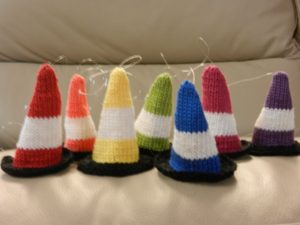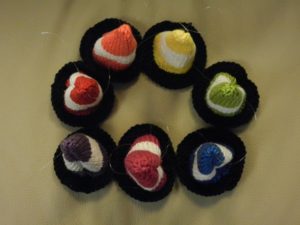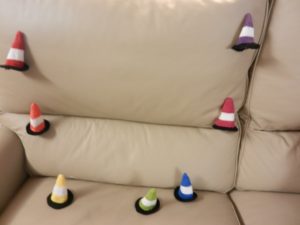Cone you believe it?
What is the attraction of traffic cones? Why do people like to move them, wear them or take them home? A friend of a friend (ahem) collected about nineteen of them over a period of six weeks so that…well, I have no idea why. I do know that he and his friends would joust with them on a Saturday night, one on each arm. They could definitely do some damage with them.
And the more he collected them, the more he seemed to come across. Little groups of them congregated on street corners on his route to work. Clusters of them lurked in the shadows of side alleys. Had they heard that there was a refuge nearby for lonely and neglected traffic cones? Were they tired of playing their part in society only to be rejected when they looked a bit tired or frayed around the edges? Did they stick together for safety, or company? Who knows?
All I can say is that when my ‘friend’ moved house, he released them back into the wild in a structured and caring manner. No dumping them on the roadside or pavement at the mercy of the bin men or passing posties; no stacking and propping them against a lamppost to feel the toe of someone’s passing boot after a night out.
 No. They were placed in a circle in a local public garden, a statement of modern times, a disparate group, a community.
No. They were placed in a circle in a local public garden, a statement of modern times, a disparate group, a community.
As my ‘friend’ closed his front door for the last time, he saw a father and son playing near the cones. The child rode his bike around the circle, then began to weave a path through, in and out of the cones. One fell over. My ‘friend’ was heartened to see that the father gently re-positioned the cone and, satisfied that it was back in place, continued to watch his son at play amid the upright grandeur of the cones. My ‘friend’ looked once more over his shoulder before setting off on his way. It was time to go…
But that’s not the end. Of course I knitted a set of cones, a string of cone bunting if you will; that goes without saying. What I learned in the process of researching the range of colours, (well, if a job’s worth doing…) is that each colour means something specific to road users. Obvious I suppose, but did you know… 
Red cones, (the one-piece Road Hog or the Dominator) temporarily redirect traffic, divert traffic lanes, create merge lanes during road work projects. So far, so obvious.
Green cones are used to signal entrances and exits for site vehicles where work is being carried out.
Blue traffic cones are used to warn of overhead structures and obstacles within road works such as power cables and bridges.
The Yellow cone, a rarity as far as I’m concerned, is commonly used as a marker for a no stopping zone. It’s role is to ensure that, when traffic flow is high, certain junctions and other bottlenecks don’t get blocked with site traffic.
If there’s a situation for which you need some cones but the standard colours just won’t do, don’t worry, there’s a raw, unpainted form, ideal for your own personal customisation, for off road use, of course.
A wedding coming up? Paint them white. Night club need a parking zone? Use Glow in the Dark paint. Hen party? Pretty pink cones can lead the way to the pub! Unpainted, the Black cone comes into its own at funerals. Who knew?
Thanks to Catherine Holland for the Connie Cone pattern, which can be found on this thoroughly entertaining website http://www.thebigknit.devonartist.co.uk/YourPatterns/ConnieCone.html
One thought on “Cone you believe it?”
Why, cones are glorious trophies, to be rescued from the monotony of their day-to-day lives, to be proudly displayed in your home!
I fully understand why your ‘friend’ would do such a thing, must be excellent genes.
Comments are closed.